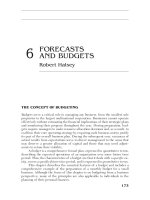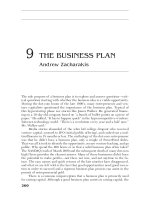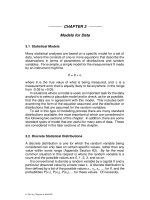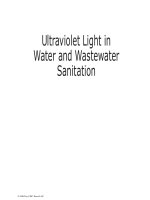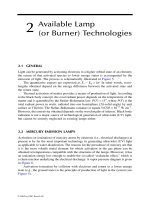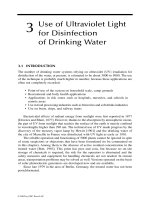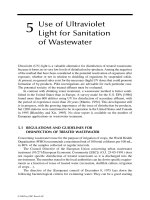CYANIDE in WATER and SOIL: Chemistry, Risk, and Management - Chapter 19 potx
Bạn đang xem bản rút gọn của tài liệu. Xem và tải ngay bản đầy đủ của tài liệu tại đây (243.33 KB, 5 trang )
19
Cyanide Treatment Technology:
Overview
George M. Wong-Chong, Rajat S. Ghosh, and
David A. Dzombak
CONTENTS
19.1 Technology Selection 387
19.1.1 Waste Characteristics 389
19.1.2 Cyanide Content of the Waste 389
19.1.3 Waste Matrix 389
19.1.4 Other Constituents of Concern 390
19.1.5 Treated Waste Quality Requirement 390
19.1.6 Cost 390
19.2 Summary and Conclusions 390
References 391
Anthropogenic cyanide has long been released to the environment through industrial effluent
discharges (e.g., chemical manufacturing, coke plants, gold mining, gas plants, and electroplat-
ing effluents) and unregulated disposal of contaminated solid wastes (e.g., aluminum manufacturing
spent pot liner, and manufactured gas plants wastes). The latter practice has resulted in contaminated
groundwater and soil. Today in the United States, environmental regulations have essentially curbed
all uncontrolled discharge practices with industry applying, for the most part, best management
practices and best available treatment technologies for the treatment of their wastes. Some areas of
earlier waste disposal practice remain problematic (e.g., former gas plant spent oxide box waste and
aluminum smelting spent pot liner disposal sites).
For the treatment of cyanide in groundwater, wastewater, sludges, and contaminated soil there
is available an array of technologies, some of which have been in commercial practice, while others
these technologies, the waste matrix to which they are most applicable, and application status (bench-
scale, pilot-scale, or commercial practice). Thetable alsoprovides comments as to industries inwhich
individual technologies are in commercial practice. Fundamental details of these technologies and
19.1 TECHNOLOGY SELECTION
Selection of an appropriate and economical treatment technology for a given waste depends on a
number of factors, including:
• Waste chemical and physical characteristics
• Quantity of waste to be treated
387
© 2006 by Taylor & Francis Group, LLC
example commercial applications are presented in subsequent chapters (Chapters 20 to 27).
have been extensively evaluated but not used in commercial practice. Table 19.1 presents a list of
388 Cyanide in Water and Soil
TABLE 19.1
Cyanide Treatment Technology: Overview
Applicable cyanide species Waste matrix Technology status
Technology Free WAD
a
FeCN
b
Wastewater Groundwater Sludge Soil
c
Bench Pilot Comm Comments
Biological
Microbial Gold mining wastewater; Coke plant
wastewater
Phytological
Chemical oxidation (low temp)
Alkaline Chlorination Electroplating wastewater
Ozonation w/o UV
UV
d
— Oxidation
Other oxidation processes
Kastone
Air/SO
2
w/CO catalyst Gold mining waste
Separation technologies
Precipitation
Coke plant wastewater with metal-CN;
SPL
e
contaminated groundwater
Carbon adsorption
CN recovery in gold mining
Ion exchange
Membrane concentration
Air/steam stripping CN recovery in gold mining
Evaporation
Thermal technologies
High temperature alkaline Aluminum industry — SPL
e
chlorination
treatment
High pressure and temperature Aluminum industry — SPL
e
alkaline hydrolysis
treatment
Incineration Aluminum industry — SPL
e
treatment
Wet air oxidation
a
WA D = weak acid dissociable cyanide.
b
FeCN = dissolved iron cyanide complexes.
c
Contaminated soil with iron-complexed cyanide.
d
UV = ultra violet irradiation.
e
SPL = spent pot liner.
© 2006 by Taylor & Francis Group, LLC
Cyanide Treatment Technology 389
• Waste matrix
• Other constituents of concern in the waste
• Treated waste quality required
• Cost
Brief discussions of these factors in the context of a specific cyanide waste follows. More detailed
discussions of these factors in the context of an overall plant- or site-wide waste management strategy
19.1.1 WASTE CHARACTERISTICS
• Water soluble forms: hydrogen cyanide and CN
−
ion (measured as free cyanide), weak
metal–cyanide complexes (e.g., cyanide complexes with cadmium, copper, nickel, and
zinc), and strong metal–cyanide complexes (e.g., cyanide complexes with cobalt and iron).
Note that the analytical measurement “weak acid dissociable (WAD) cyanide” includes
free cyanide and any weak metal–cyanide complexes, while “total cyanide” includes WAD
and any strong metal–cyanide complexes.
• Water insoluble forms: transition metal–metal cyanide complex compounds, for example,
ferric ferrocyanide or Prussian Blue, Fe
4
(Fe(CN)
6
)
3
(s). When these solid form com-
pounds are placed in water, they dissolve to varying extents, ultimately to their equilibrium
solubility limits, yielding low dissolved concentrations of metal–cyanide complexes under
natural environmental conditions. This solubility may pose certain treatment challenges
and regulatory concerns.
19.1.2 CYANIDE CONTENT OF THE WASTE
The cyanide content of the waste (concentration and quantity) and treatment requirements directly
impact the selection, size, and cost of the treatment system. For relatively small quantities of waste,
as is sometimes the case with contaminated soils, off-site management (e.g., landfill disposal or
incineration) would be more cost effective than on-site treatment. Vice versa, with large continuously
generated wastewater streams, on-site treatment tends to be more cost effective.
19.1.3 WASTE MATRIX
Cyanide occurs in numerous waste matrices, including:
• Wastewaters generated from manufacturing operations, which can contain many chemical
constituents, and both soluble and insoluble entities.
• Contaminated groundwater, which can sometimes contain immiscible organic liquids,
also known as “free product” (e.g., light nonaqueous phase liquids, or LNAPL, and dense
nonaqueous phase liquids, or DNAPL).
• Contaminated soil and soil slurries.
• Contaminated sediment (e.g., dredge spoils).
• Manufacturing waste sludges.
These various waste matrices greatly influence treatment technology selection. In some cases,
ancillary treatment processes may be required to ensure the proper operation of the “primary”
treatment technology and overall compliance with requisite regulatory limits. The following two
© 2006 by Taylor & Francis Group, LLC
are presented in Chapters 26 and 27.
In a given cyanide waste, cyanide can exist in numerous forms/species (discussed in Chapters 2, 5,
7, and 8), all of which impact the selection of a treatment technology. These forms include:
390 Cyanide in Water and Soil
examples illustrate the differences in treatment schemes needed for similar wastes (e.g., groundwater
contaminated with dissolved iron cyanide) in different matrices:
1. Matrix A, groundwater only: effective treatment can be achieved with iron cyanide
precipitation only.
2. Matrix B, groundwater with LNAPL: effective treatment requires the separation of the
LNAPL prior to iron cyanide precipitation.
19.1.4 OTHER CONSTITUENTS OF CONCERN
The presence of other constituents of concern in the waste stream to be treated affects the treatment
technology selection and often leads to a train of treatment processes to produce desired treated waste
quality. Two examples illustrate the differences in treatment schemes needed for different types of
wastes with different regulatory concerns.
• Gold mining tailings: These wastes can contain WAD cyanides, strong metal-cyanide
complexes, thiocyanate, and trace metals. Biological treatment has proven effective in
treating these wastes. The WAD cyanides and thiocyanate are degraded to carbon dioxide,
ammonia and sulfate; the strong cyanide complexes and trace metals are adsorbed on to
the biological materials; and ammonia is biologically oxidized to nitrate [1].
• Coke plant wastewaters: These wastewaters contain ammonia, WAD cyanide, strong
metal-cyanide complexes, phenols, other organics, thiocyanate, sulfide, and trace ele-
ments. Treatment of these wastewaters requires a complex treatment train if all of these
constituents are of regulatory concern. The treatment train can include: steam stripping
to remove ammonia, WAD cyanide and sulfide; biological treatment for ammonia, resid-
ual WAD cyanide, phenols, organics, thiocyanate, and sulfide; chemical precipitation for
fluoride and strong metal cyanide complexes [2].
19.1.5 TREATED WASTE QUALITY REQUIREMENT
This regulatory factor is the primary driving force for treatment and it dictates the degree of treatment
that must be achieved. Regulatory requirements and concerns with these requirements are discussed
19.1.6 COST
The cost of treatment for a given waste stream can vary greatly depending on site-specific condi-
tions and circumstances. Certain publications have provided cost information [1,3–5] specifically
focused on treatment of cyanide-bearing wastes. However these cost data are somewhat outdated
and should be adjusted for the time since publication. Even with inflation adjustment they should be
considered as preliminary guides at best because of the changes in technology markets and global
economics. In subsequent chapters, some additional treatment costs and guidelines are provided for
specific technologies.
19.2 SUMMARY AND CONCLUSIONS
• An array of technologies exists for treatment of cyanide species in wastewaters,
groundwaters, soils, and sludges.
• Selection of appropriatetechnology for a given waste depends on various factors, including
physico-chemical characteristics of the waste matrix, treatment volume, required treatment
level, and cost.
© 2006 by Taylor & Francis Group, LLC
in detail in Chapter 18.
Cyanide Treatment Technology 391
• Compilations of cost information for certain cyanide treatment technologies exist but are
somewhat outdated. Technology cost information from these compilations should be used
only for preliminary assessments.
REFERENCES
1. Whitlock, J.L. and Mudder, T., The Homestake wastewater treatment process: biological removal of
toxic parameters from cyanidation wastewaters and bioassay effluent evaluation, in Cyanide Monograph,
Mudder, T., Ed., Mining Journal Books, Ltd., London, 1998.
2. Wong-Chong, G.M., Sommerfield, F.J., and Velegol, D.J., Coke plant wastewater treatment at Bao Shan
Steel, Shanghai, China, in Proceedings of WEFTEC Latin America, Rio de Janiero, 2000.
3. Smith, A. and Mudder, T., The Chemistry and Treatment of Cyanidation Wastes, Mining Journal Books,
Ltd., London, 1991.
4. Mudder, T., Ed., Cyanide Monograph, Mining Journal Books, Ltd., London, 1998.
5. Palmer, S.A.K., Breton, M.A., Nunno, T.J., Sullivan, D.M., and Suprenant, N.F., Metal/Cyanide
Containing Wastes: Treatment Technologies, Noyes Datacorp., Park Ridge, NJ, 1988.
© 2006 by Taylor & Francis Group, LLC
